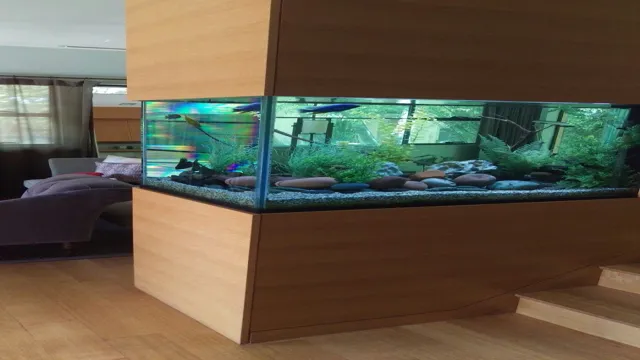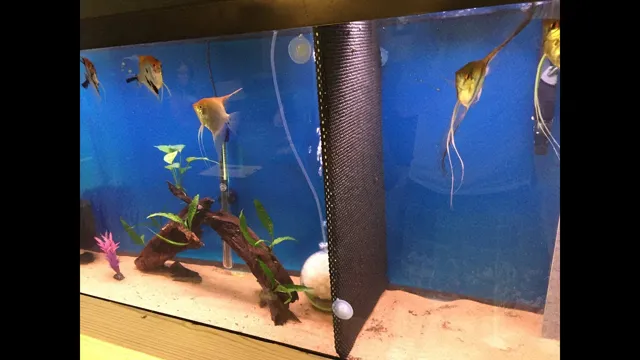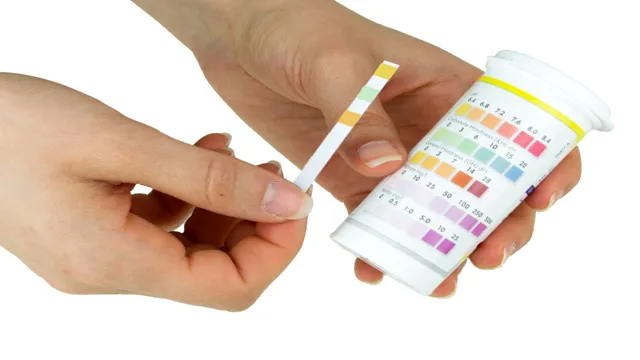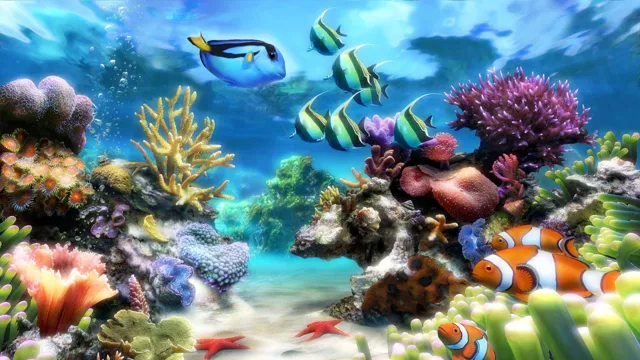As aquarium hobbyists, we always want to provide the best possible living conditions for our fish. Sometimes, we need to separate fish within a tank to prevent aggression or hostility. This is where adding a permanent divider in an aquarium becomes necessary.
A permanent divider is a great way to create a peaceful environment for your aquatic pets without sacrificing space. In this blog, we’ll explore the benefits of adding a permanent divider and how to DIY one for your own tank. So, whether you’re a beginner or experienced hobbyist, let’s dive into the world of aquarium dividers!
The Importance of Dividers in Aquariums
If you have an aquarium with multiple fish but find that some of them aren’t getting along, adding a permanent divider can be a great solution. A divider separates your aquarium into two or more sections, allowing you to keep different species or aggressive fish apart. To add a permanent divider, start by measuring the width and height of your aquarium.
Cut a piece of acrylic or glass to fit snugly into the tank, being careful not to leave any openings where fish can swim through. Silicone the divider in place, and let it dry for at least 48 hours before adding water or fish. With the right materials and some patience, creating a permanent divider can be a simple and effective way to maintain peace in your aquarium.
Remember to consider the needs of each species and keep a close eye on their behavior to ensure they remain happy and healthy in their separate spaces.
Preventing Fish Aggression and Injuries
Dividers If you have a community tank, then you know how important it is to keep everyone happy and healthy. But sometimes aggression can occur, leaving some fish injured or stressed. This is where dividers can come in handy.
Dividers can be placed in the tank to separate aggressive fish from gentler ones. This not only helps prevent any injuries but also reduces stress levels. Think of dividers as a barrier to keep everyone in their own space, much like having your own bedroom in a shared house.
It’s essential to choose a divider that fits your tank size and the type of fish you have. Some dividers come with a feeding hole to allow easy access for your fish’s daily meals. So if you’re experiencing any aggression problems in your community tank, consider adding a divider to help keep the peace.

Creating Separated Spaces for Different Species
When it comes to aquariums, it’s crucial to create separated spaces for different species. That’s where dividers come in handy. Not only do dividers help to keep your fish safe, but they also prevent any fights among different species.
Without them, some fish may become overly aggressive towards others, which can lead to injury or even death. Dividers can be made from a variety of materials, such as plastic or glass, and can be easily installed in any aquarium. They’re also a great way to section off parts of the tank for different purposes, such as breeding or quarantine.
So, if you want to create a safe, healthy environment for your fish, be sure to invest in some dividers. They may seem like a simple addition, but they can make all the difference in the world for the wellbeing of your aquatic pets.
Choosing the Right Divider Material
Adding a permanent divider in an aquarium can be a great way to separate fish that may not get along or require different living conditions. When choosing the right divider material, it’s important to consider the temperament and behavior of your fish to ensure the divider can withstand any potential damage or aggression. Acrylic dividers are a popular choice as they are strong, lightweight, and flexible, making them less likely to crack or shatter under pressure.
Glass dividers are also commonly used, but may be prone to breaking if not reinforced properly. It’s important to measure the dimensions of your aquarium and choose a divider thickness that will fit securely without bowing or slipping. Ultimately, the right divider material will depend on your specific aquarium setup and the needs of your fish. (See Also: How to Measure the Size of Aquarium at Sea World Grill – A Comprehensive Guide)
Glass Dividers vs Acrylic Dividers
When it comes to choosing dividers for your workspace, glass and acrylic are the two primary options available. Glass dividers provide a sleek and modern aesthetic to any space, but they can be heavy and expensive. On the other hand, acrylic dividers are lightweight and affordable, but may scratch and scuff easily.
When choosing between glass and acrylic dividers, consider the purpose of your space and your budget. Glass dividers may be the better choice for executive offices and conference rooms, while acrylic dividers may be more suitable for classrooms and workstations. It’s also important to consider the durability of the materials.
While glass is more durable in the long run, it requires careful handling during installation and maintenance. Acrylic, on the other hand, is easy to clean and maintain, but may require replacement if it becomes heavily scratched or damaged. Ultimately, the decision between glass and acrylic dividers comes down to your specific needs and preferences.
Both materials have their pros and cons, and it’s important to weigh them carefully before making a final decision.
Considerations for Tank Size and Thickness
When it comes to setting up a tank, choosing the right divider material is essential in ensuring the safety and wellbeing of your aquatic pets. Acrylic dividers are a popular choice for their transparency and durability. They are easy to install and maintain, allowing for clear visibility of your aquarium inhabitants.
Additionally, acrylic dividers tend to be thicker than their glass counterparts, which means they can withstand more pressure without cracking or breaking. This is especially important when considering the size of your tank and the thickness of the divider needed to properly separate different species or create designated areas within the tank. Ultimately, the right divider material is one that can support the weight of your water, the tank size, and the activity levels of your fish for a safe and happy aquatic environment.
Installing the Divider
Installing a permanent divider in your aquarium is a great way to separate different species or provide a safe space for fish to hide. To do this, you will need to measure the length and height of your aquarium and purchase a divider made of sturdy material like acrylic or glass. Next, clean the area where you want to install the divider and apply aquarium sealant along the bottom edge.
Gently place the divider in the sealant, pressing down firmly to ensure a secure hold. Allow the sealant to dry completely before adding water and fish to your aquarium. With the right tools and a little patience, adding a permanent divider is an easy and effective way to improve the safety and comfort of your aquatic pets.
Measuring and Cutting the Divider
Installing a divider in your space can effectively create separate areas to increase functionality and privacy. Once you have decided where the divider will go, it’s time to measure and cut the divider to fit your space. First, measure the length and height of the area where you want to install the divider.
Using these measurements, cut the divider to the correct size, making sure to leave enough room for installation hardware. Ensure that the divider is level by using a level tool, and make any necessary adjustments before attaching it to the wall or floor. With the divider now installed, you can enjoy a more functional and visually engaging space.
Remember to measure twice and cut once to ensure an accurate fit for your divider.
Applying Silicone Adhesive to the Divider
When it comes to installing dividers, applying silicone adhesive is a crucial step in creating a secure and long-lasting partition. To begin, make sure that the divider is clean and dry before applying the adhesive. Squeeze the silicone onto one side of the divider, starting at the bottom and working your way up.
Use a caulking gun and apply the adhesive evenly along the length of the divider. Then, place the divider into the desired position and press firmly to ensure a tight fit. Be sure to remove any excess adhesive with a damp cloth, and allow ample time for the adhesive to dry before using the divider. (See Also: How to Lower pH in My Aquarium: Tips and Tricks for Maintaining Healthy Water Chemistry)
Remember, a good silicone adhesive will improve the durability and stability of your divider, ultimately increasing its lifespan. So, take your time in applying the adhesive and be sure to do it correctly, to guarantee your divider stays firmly in place.
Securing the Divider in Place
Installing the divider in the machine is only half the battle, as you must also ensure that it is secured in place. One of the most common ways to do this is by using bolts or screws to fasten it to the appropriate surfaces. The first step is to drill or punch holes where the bolts or screws will go, being sure to align them correctly with the divider.
Once the holes are in place, insert the bolts or screws through both the divider and the surface it will be attached to, and tighten them firmly. Another method of securing the divider is by using clamps, which are often preferred for their ease of use and flexibility. These can be tightened or released as needed, making it easy to adjust or remove the divider when necessary.
Whichever method you choose, be sure to check on the divider periodically to ensure that it is still securely in place and not shifting or loosening over time. By taking the time to properly secure the divider, you can help prevent accidents and ensure that your machine operates safely and efficiently. Keyword: securing the divider
Maintaining the Divider
Adding a permanent divider in an aquarium can help keep your fish separated and safe. However, it’s important to maintain the divider to ensure its effectiveness. One way to do this is to regularly clean the divider with a soft-bristled brush or sponge to remove any debris or algae buildup.
It’s also important to regularly test the water on both sides of the divider to make sure the water conditions are consistent and safe for your fish. Additionally, you should monitor the divider for any signs of damage, such as cracks or leaks, and replace it if necessary. By taking these steps, you can ensure that your permanent divider continues to provide a safe and healthy environment for your fish.
Cleaning and Preventing Algae Growth
Maintaining the divider in your pond or aquarium can be a hassle, but it’s crucial to keep it clean and prevent algae growth. Algae is not only unsightly, but it can also be harmful to your fish and other aquatic life. To clean the divider, simply use a soft-bristled brush or sponge to gently scrub away any algae buildup.
If the algae is particularly stubborn, you can use a commercially available algae scraper. It’s also important to regularly remove any debris or fallen leaves that may have settled on the divider. To further prevent algae growth, consider using an algae inhibitor or installing a UV sterilizer.
With regular maintenance, your divider will stay clean and clear, providing a healthy environment for your aquatic inhabitants to thrive.
Inspecting and Repairing the Divider
Maintaining the divider is crucial to ensure that it functions properly and lasts a long time. Inspection and repair of the divider should be done regularly to avoid sudden breakdowns. To inspect the divider, you need to check its moving parts, lubrication, and tension.
These components need frequent attention as they can wear down and cause damage to the machine. If you spot any issues, it’s best to address them as soon as possible to prevent further damage. You can do some repairs on your own, but others may require a professional.
Ignoring issues can lead to costly repairs or even a complete breakdown of the divider. With proper maintenance, you’ll be able to keep your divider working efficiently and save money on repairs in the long run. (See Also: How to Grow Moss on Aquarium Wall High Light: A Step-by-Step Guide)
Conclusion
In conclusion, adding a permanent divider to your aquarium doesn’t have to be a fishy business. With a little bit of creativity, a few simple tools, and some elbow grease, you can create a unique and stylish partition that will not only keep your fish separate, but also add some flair to your aquatic oasis. Whether you choose to use glass or acrylic, silicone or suction cups, the possibilities are endless when it comes to customizing your tank.
So don’t be afraid to dive in and get creative – the end result will be a divider that you and your fish will be proud to call home!”
FAQs
What are the benefits of having a permanent divider in an aquarium?
A permanent divider in an aquarium can help to provide separate spaces for different fish to reduce aggression, prevent breeding, and manage water parameters separately.
How do you install a permanent divider in an aquarium?
To install a permanent divider in an aquarium, measure the space and cut a piece of acrylic or PVC to fit. Attach suction cups or brackets to secure the divider in place.
Can a permanent divider harm aquarium fish?
A properly installed permanent divider should not harm aquarium fish. However, it is important to monitor the fish’s behavior and adjust the divider or remove it if necessary.
How do you clean a permanent divider in an aquarium?
To clean a permanent divider in an aquarium, use a soft-bristled brush and gentle scrubbing in a solution of water and vinegar or mild soap. Rinse thoroughly before reinstalling.
What materials can be used to make a permanent aquarium divider?
Acrylic, PVC, glass, or mesh can be used to make a permanent aquarium divider. Choose a material that is safe for aquarium use and appropriate for your aquarium size and setup.
Can a permanent aquarium divider be customized to fit different aquarium sizes?
Yes, a permanent aquarium divider can be customized to fit different aquarium sizes by cutting the material to the appropriate size and using suction cups or brackets to secure it in place.
Do all aquariums need a permanent divider?
No, not all aquariums need a permanent divider. It depends on the type and number of fish, their behavior, and the aquarium setup. Consult with a knowledgeable aquarium expert for advice.







